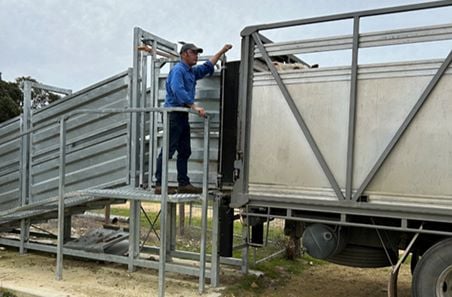Back to Tools, resources and training

 Bordertown, SA
Bordertown, SA
Transporting bulls
- Communicate clearly with your transport operator the weight and age (if known) of the bulls for dispatch.
- Lighter penning density is an important consideration for bulls.
Social hierarchy
- Consider penning mature bulls separately – discuss with your transport operator.
- Alternatively, ensure that bulls are run together for a minimum of 2–3 days prior to loading. The longer the better, as this gets them accustomed to each other and settled in the yards. They work out their social hierarchy, which tends to be a more physical process with bulls. It is far better for this to happen in the yards than on the truck and results in less complications during transport. During this time, provide good quality, dry hay and clean water.
- Once settled and moving, bulls will generally be OK.
Condition and health
- Bulls with a swollen pizzle are not fit for loading.
- Bulls exhibiting significant lameness that impacts their ability to walk and stand comfortably are not fit to load. They would be at high risk of going down in the truck.
- Getting too hot can impact bull fertility. It is important to consider predicted temperatures, air flow and shade for bulls in transport.
Dangerous or mickey bulls
- Scrub/mickey bulls are a much higher-risk class of cattle, therefore provide as much yard time as possible prior to transport. One week minimum is recommended. In this time, include familiarisation with people, vehicles, feeders, machinery etc., and provide good quality, dry hay prior to transport.
- Identify any dangerous animals prior to the truck arriving and communicate clearly with the driver which animal/s are higher risk (wild). Bulls that have had limited or no human interaction prior to mustering and yarding are often the highest risk class of cattle to handle and transport.
Safe loading
- Have multiple people on hand to load, to minimise risk. Never load alone – this is a significant Work Health Safety risk.
- No-one should be in the crate with this class of cattle and all gates should be operated from outside the crate to avoid risk of injury.
Allow time to adjust before joining
- It is best to give bulls time to adjust to their new location before joining. The bigger the change in temperature, humidity and nutrition the longer bulls need to adapt.
Case studies

Lachy’s top tips for maintaining condition of stud bulls and rams in transport
When buying stud bulls and rams, Lachy Day says preparing for the journey home can help to minimise stress, optimise fertility and keep the animals in the best condition for working.
 Bordertown, SA
Bordertown, SA


